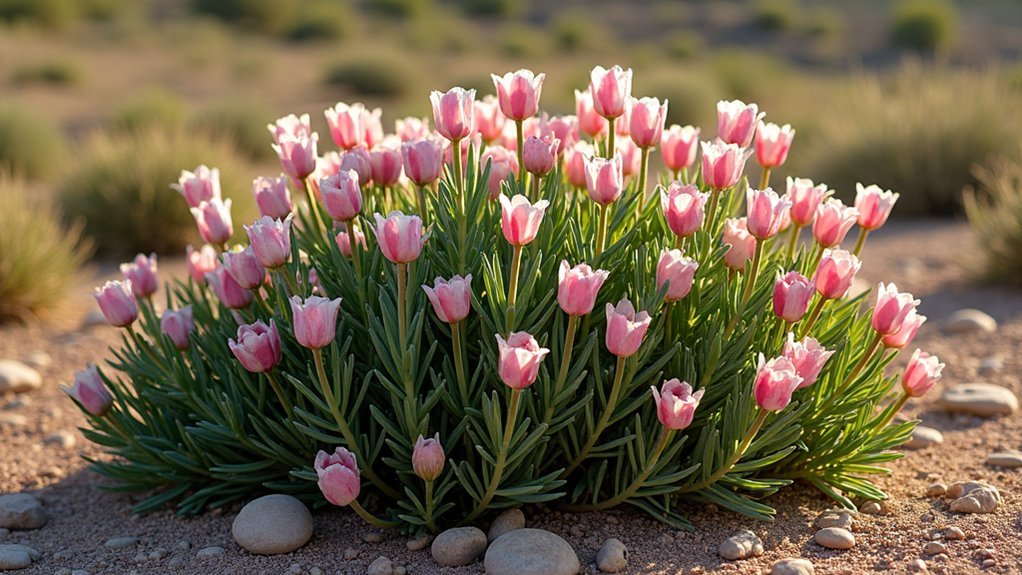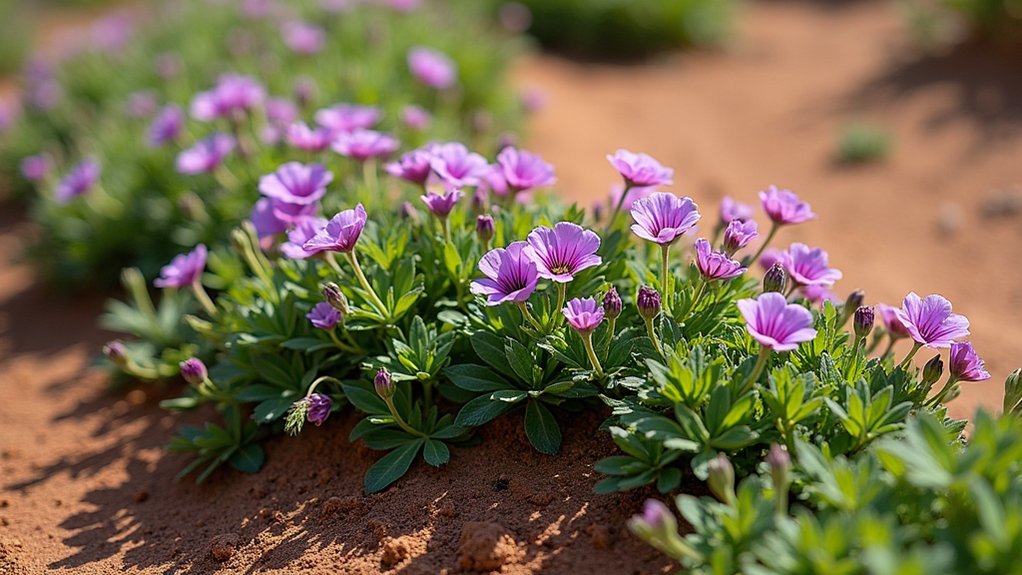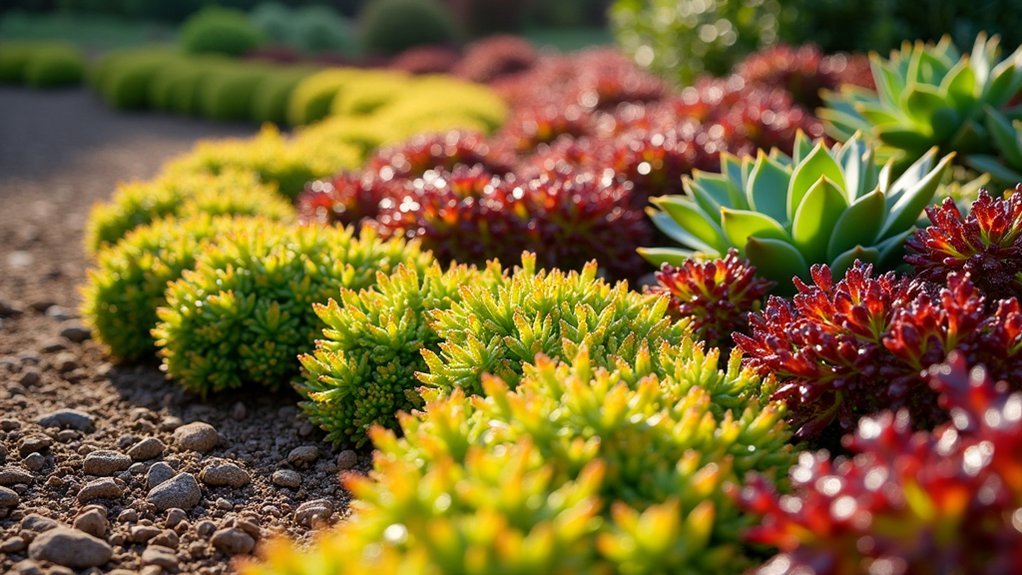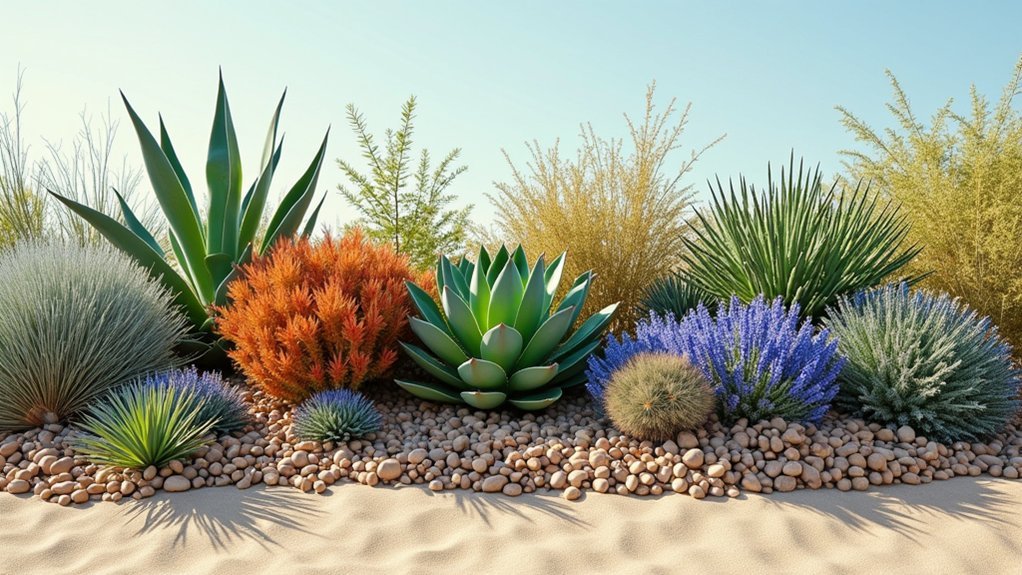Create natural boundaries with these drought-hardy plants: Black-Eyed Susan, Verbena, Wild Lilac, Rockrose, Marina Strawberry Tree, Blue Fescue Grass, Cranesbill Geranium, Blanket Flower, Russian Sage, and Sedum groundcovers. They’ll thrive with minimal watering once established and offer year-round visual interest through colorful blooms, distinctive foliage, and varied heights. Most attract beneficial wildlife while deterring pests and deer. Discover how these resilient options can transform your landscape while saving water.
Verbena: Purple Blooms That Thrive in Dry Conditions

When seeking drought-tolerant plants with striking visual appeal, verbena stands out as an exceptional choice for water-conscious gardeners. ‘Homestead Purple’ creates impressive natural boundaries with its spreading habit, reaching 12 inches tall and 36 inches wide, while producing vibrant purple flower clusters visible from a distance.
You’ll appreciate verbena’s adaptability in USDA zones 6-10, tolerating temperatures down to 3°F when established. It thrives in full sun and well-drained soil but rebels against soggy conditions. After establishment, it requires minimal watering, making it perfect for xeriscaping.
Beyond drought tolerance, verbena attracts butterflies and hummingbirds while deterring deer and rabbits. Available at Taylor’s Nursery, this vibrant purple flower is a favorite among gardeners seeking pollinator-friendly plants.
Enjoy a garden buzzing with beneficial wildlife while naturally protecting your plants from common pests.
Whether cascading over walls, filling containers, or creating low borders, its extended bloom season from spring through fall delivers continuous color with minimal maintenance.
Wild Lilac (Ceanothus): A Pollinator-Friendly Boundary Solution
You’ll love how Wild Lilac transforms your garden boundaries with its vibrant blue, purple, or white flower clusters that buzz with bee activity throughout spring.
These California natives require almost no water once established, thriving in even the harshest drought conditions while creating a stunning visual impact.
Ceanothus varieties range from low-growing groundcovers to 20-foot trees, giving you versatile options for creating drought-resistant privacy screens that support local pollinators. For the best results, plant them in nutritionally lean soil where they’ll flourish without the need for fertilizers.
Vibrant Bee Magnet
Wild lilac (Ceanothus) transforms ordinary boundaries into buzzing biodiversity hotspots with its magnetic appeal to pollinators.
You’ll notice intense bee activity during its peak blooming period (March-May), when dense clusters of honey-scented flowers provide essential nectar and pollen resources.
The blue-hued varieties are particularly effective at attracting native bees, including specialist pollinators that specifically seek out Ceanothus. This drought-tolerant shrub requires minimal maintenance while providing maximum ecological benefits in your landscape.
This timing perfectly coincides with peak foraging periods when many bee populations are establishing new colonies.
Drought-Tolerant Beauty
While many garden plants wilt during water restrictions, Ceanothus thrives with minimal irrigation, making it a champion for drought-conscious landscapes. This West Coast native adapts to poor soils and can withstand temperatures down to 15°F, offering versatility across various regions.
You’ll appreciate how Wild Lilac establishes itself with little maintenance once planted. Its extensive root system stabilizes slopes and prevents erosion, while simultaneously fixing nitrogen to improve your soil naturally.
Choose from a range of sizes and colors—from low-growing ‘Yankee Point’ for ground cover to the impressive ‘Victoria’ that reaches 9 feet tall. Plant varieties like ‘Blue Jeans’ or ‘Dark Star’ for prolific flowering and cold hardiness. The glowing blue flowers create a stunning display while attracting beneficial insects to your garden.
For best results, plant in well-drained soil during cooler seasons and let nature do the rest.
Rockrose (Cistus): Evergreen Borders for Well-Drained Sites

If you’re looking for a heat-loving addition to your rock garden, rockrose (Cistus) thrives in parched, sunny spots where other plants struggle.
These tough Mediterranean natives bring year-round structure with their dense, aromatic foliage and reward you with papery white, pink, or yellow blooms each summer.
Their mounding growth habit forms natural boundaries while requiring minimal care once established, making them perfect partners for other drought-tolerant plants like lavender and rosemary. Rockrose plants prefer to grow in poor-quality rocky soils that would be challenging for most ornamental species.
Heat-Loving Rock Garden Star
Few drought-hardy plants combine elegance and resilience like Rockrose (Cistus spp.). Native to the Mediterranean basin, this flowering evergreen thrives in full sun and scorching conditions that would wither less hardy specimens.
You’ll appreciate Rockrose’s fast growth and mounding structure, reaching 3-5 feet in both height and width. Its summer blooms appear in charming pink, white, or yellow shades, creating visual interest against its year-round green foliage. Some varieties like Cistus ladanifer feature distinctive dark brown blotches at the base of their petals, adding to their ornamental appeal.
For coastal gardens or challenging slopes, this shrub proves invaluable.
Plant Rockrose in well-drained soil of any pH level, and you’ll enjoy its bushy form with minimal maintenance. Beyond its landscape value, this deer-resistant beauty offers aromatherapeutic benefits with its sweet-smoky fragrance—a perfect addition to your water-wise garden design.
Year-Round Mediterranean Appeal
Transforming everyday borders into Mediterranean escapes, Rockrose (Cistus) offers year-round structure with its silvery-green foliage and papery blossoms.
This versatile evergreen thrives in sun-drenched, well-drained sites where other plants struggle.
You’ll appreciate Rockrose’s minimal maintenance requirements while enjoying its showy flowers in white, pink, or purple that attract beneficial pollinators.
Its compact growth pattern creates neat hedges or informal borders, complementing both structured and naturalistic landscapes.
Beyond its ornamental value, Rockrose serves practical purposes too. Its unique seasonal dimorphism allows it to develop shorter leaves in summer and longer ones in winter, perfectly adapting to Mediterranean climate variations.
Its deep roots help control erosion on slopes, while its drought resistance makes it perfect for water-conscious gardening.
Whether you’re aiming for authentic Mediterranean aesthetics or simply need tough plants for challenging conditions, Rockrose delivers beauty and resilience in equal measure throughout all four seasons.
Black-Eyed Susan: Resilient Native Beauty for Sunny Boundaries
Golden beacons in the landscape, Black-Eyed Susans offer exceptional drought tolerance while creating stunning natural boundaries in sunny gardens.
These North American natives thrive with minimal care across USDA zones 2-11, requiring at least six hours of direct sunlight daily.
Resilient beauties that flourish from frigid Canada to tropical Florida, demanding only sunshine and basic attention to perform their summer show.
You’ll appreciate their adaptability to various soil types and their bright yellow-orange blooms with distinctive brown centers. Standing 1-3 feet tall, they’re perfect for borders, mass plantings, and cut flower arrangements. Their salt tolerance makes them ideal for coastal landscapes.
Beyond aesthetics, Black-Eyed Susans support local ecosystems by attracting bees and butterflies. They require regular deadheading to extend their blooming season well into fall. They’ll self-seed readily, ensuring continuous displays year after year, though you might need to manage their spread to prevent them from becoming weedy in adjacent beds.
Marina Strawberry Tree: Ornamental Barrier With Edible Benefits

The Marina Strawberry Tree offers an exceptional combination of beauty and functionality for drought-tolerant landscapes. This Mediterranean hybrid grows 20-50+ feet tall with deep green leaves and eye-catching peeling bark that reveals red undertones. It produces rosy pink flowers during fall and winter, adding seasonal charm to your landscape.
| Feature | Benefit |
|---|---|
| Peeling bark | Year-round visual interest |
| Pink-white flowers | Aesthetic appeal in blooming season |
| Red “strawberry” fruits | Attracts birds, wildlife support |
| Dense evergreen foliage | Effective natural screening |
You’ll appreciate its versatility as a specimen tree, multi-stemmed shrub, or informal hedge. While drought-tolerant, it benefits from occasional deep watering during summer months. Hardy to 15-20°F, this tree thrives in full sun and requires minimal maintenance once established. The edible (though flavorless) fruits add ecological value by supporting local bird populations.
Blue Fescue Grass: Compact Blues for Modern Border Designs
Blue fescue grass emerges as an ideal choice for drought-resistant landscapes where compact size and distinctive coloration are priorities. Its silvery blue-green mounds reach just 6-12 inches tall while spreading 6-18 inches wide, creating natural boundaries with minimal maintenance.
You’ll appreciate this versatile grass in USDA zones 4-8, where it thrives in full sun and well-drained soil. Once established, blue fescue requires almost no supplemental watering, making it perfect for xeriscaping projects. The Elijah Blue variety forms a handsome blue-green clump that won’t choke out neighboring plants in your garden design.
For maximum design impact:
- Plant in groups along pathways to define edges
- Contrast with vibrant flowering perennials for color pop
- Use in rock gardens where its drought tolerance excels
- Incorporate into modern landscape designs for contemporary texture
Remove flower stalks after blooming to maintain neat appearance and prevent unwanted self-seeding.
Cranesbill Geranium: Spreading Perennial for Erosion-Prone Edges

Hardy cranesbill geraniums offer an elegant solution for stabilizing erosion-prone areas while adding delicate beauty to your landscape. Their spreading habit and deep roots effectively hold soil in place, making them perfect for sloped gardens or areas vulnerable to runoff.
Unlike their annual cousins, these perennials feature smaller, more refined leaves and flowers in stunning shades from white to near-black purples. Popular varieties like Geranium Rozanne and Havana Blues provide vibrant blooms that enhance any outdoor space. They’ll thrive in part to full sun and adapt to various soil conditions, though they prefer rich, loamy earth.
Delicate blooms in captivating colors, hardy cranesbill geraniums offer understated elegance while adapting beautifully to your garden’s conditions.
You’ll appreciate their low maintenance nature—they’re drought-tolerant once established and naturally resist deer browsing. For best results, occasionally shear back foliage to maintain shape and promote continued flowering.
Use them as garden bed fillers, natural-looking edging, or textural accents in wild garden designs.
Blanket Flower: Vibrant Color Through Summer Drought
Blanket flowers will reward you with their vibrant blooms throughout even the most brutal heat waves, maintaining their color when other plants have withered.
You’ll appreciate how these drought-hardy perennials attract a steady stream of butterflies, bees, and birds to your garden year-round.
Their under-12-inch height makes them perfect for border plantings, requiring almost no maintenance beyond occasional deadheading to keep the color show running all summer. These resilient plants actually thrive better and produce more flowers when planted in poor soil rather than rich, amended garden beds.
Resilient Heat-Wave Performer
When summer heat waves strike, few plants continue to perform as admirably as the Blanket Flower (Gaillardia). This tough perennial thrives when temperatures soar, making it an excellent choice for your drought-prone garden borders.
You’ll appreciate its remarkable resilience during the hottest months, as it requires minimal attention once established.
Blanket Flowers excel in challenging conditions where other plants struggle:
- Thrives in poor soil with little fertilization
- Performs exceptionally well during extended heat waves
- Requires minimal watering after establishment
- Continues blooming from summer through early fall
For best performance, plant your Blanket Flowers in full sun with well-drained soil. Their mounding or sprawling growth habit creates natural-looking boundaries that blend beautifully with prairie or meadow garden designs.
Deadhead spent blooms to encourage more flowers, or leave them to attract goldfinches and allow for natural self-seeding throughout your garden.
Wildlife Magnet Year-Round
Beyond their drought resistance, Blanket Flowers serve as natural wildlife magnets throughout the seasons, creating a vibrant ecosystem in your garden. You’ll enjoy watching bees and butterflies flock to these colorful blooms from early summer until first frost.
What’s more impressive is their deer and pest resistance, making them perfect for wildlife boundaries where you want to attract beneficial insects while deterring unwanted visitors. These North American natives also provide impressive blooms with solitary disc flowers surrounded by beautiful rays that create their distinctive appearance.
| Wildlife Benefit | Season | Impact |
|---|---|---|
| Butterfly haven | Summer | Soul-lifting |
| Bee attraction | Spring-Fall | Garden-energizing |
| Seed source | Winter | Bird-sustaining |
| Deer resistance | Year-round | Frustration-saving |
| Visual delight | All seasons | Mood-enhancing |
Place these hardy perennials in full sun with well-drained soil and you’ll create a thriving habitat that requires minimal attention from you.
Low-Maintenance Border Champion
Along the edges of your garden, few plants perform as admirably as the Blanket Flower in creating vibrant, carefree borders that thrive despite summer’s heat.
These drought-tolerant perennials demand minimal attention while delivering maximum impact with their striking red and yellow blooms from early summer until first frost.
Blanket Flowers excel as border champions because they:
- Require almost no supplemental watering once established
- Flourish in poor, well-drained soils without fertilizer
- Resist deer and rabbit damage, protecting your boundary
- Maintain continuous flowering when deadheaded regularly
Plant your Gaillardia in full sun with sandy or loamy soil for best results. The Arizona Sun variety, reaching just 10 inches tall, creates an ideal compact border without overwhelming neighboring plants.
Their compact, multi-stemmed growth habit creates a tidy border that won’t become leggy or sparse when properly sited—just the low-maintenance performer you need for water-wise garden boundaries.
Russian Sage: Silver Foliage for Striking Boundary Definition
Russian Sage stands as a striking silver sentinel in drought-tolerant landscapes, offering both visual drama and practical boundaries for garden spaces.
Native to Central Asia, this subshrub thrives in USDA zones 4-9 with minimal care.
Thriving effortlessly across diverse climates, this Central Asian beauty asks little while offering remarkable resilience.
You’ll appreciate its grayish-silvery green foliage that contrasts beautifully with lavender-blue flowers in mid to late summer.
Growing 2-5 feet tall, it’s ideal for defining garden boundaries, creating informal hedges, or filling mixed borders.
Plant Russian Sage in full sun and well-drained soil for best results.
Cut it back almost to the ground in early spring to encourage fresh growth.
Consider ‘Little Spire’ if you’re working with smaller spaces, or ‘Blue Spire’ for deeper color impact.
Its drought tolerance, pest resistance, and salt tolerance make it perfect for challenging landscape conditions.
Sedum Groundcovers: Low-Maintenance Border Solutions

Sedums offer a perfect solution for gardeners seeking resilient, attractive groundcovers that define borders with minimal effort.
These succulents thrive in poor, well-drained soils and require little attention once established, making them ideal for busy homeowners or drought-prone areas.
You’ll find sedums particularly valuable along pathways, between stepping stones, or cascading over rock garden edges.
Their versatile leaf colors—from blue-gray to reddish-bronze—and seasonal blooms in pink, yellow, or white add visual interest to your landscape boundaries.
For successful sedum borders:
- Plant in full sun to light shade
- Guarantee excellent drainage to prevent root rot
- Space plants 12-18 inches apart to allow for spreading
- Water sparingly after establishment to maintain drought tolerance
Frequently Asked Questions
How Do I Prevent Boundary Plants From Invading Neighboring Properties?
Install deep edging barriers, choose less invasive species, maintain regular trimming, and use containment methods. You’ll also want to communicate with your neighbors and inspect boundaries often to catch any unwanted spread early.
Can Drought-Tolerant Boundary Plants Survive Winter Freezes?
Yes, many drought-tolerant boundary plants can survive winter freezes. Choose varieties suited to your hardiness zone, mulch well for root insulation, and select species with known cold tolerance like ornamental grasses or certain evergreens.
Which Boundary Plants Deter Deer and Other Wildlife Pests?
You’ll find deer and wildlife are deterred by aromatic plants like lavender and Russian sage, thorny barriers like barberry, fuzzy-leaved species like lamb’s ear, and spiky plants like yucca and ornamental grasses.
How Quickly Will These Plants Establish a Privacy Screen?
Fast-growing options like Leyland Cypress and Green Giant Arborvitae establish privacy within 2-3 years. You’ll see significant screening in year one if you provide proper initial watering and plant in full sun.
Are Any Drought-Tolerant Boundary Plants Toxic to Pets?
Yes, several drought-tolerant boundary plants are toxic to pets. Lantana’s berries, Barberry, and Tuscan Rosemary can cause issues if ingested. Consider safer alternatives like Creeping Mahonia, Russian Sage, or Blue Fescue instead.
In Summary
You’ll find these drought-hardy plants offer the perfect solution for defining your property lines while conserving water. They’re not just practical—they’re beautiful additions that attract pollinators and wildlife. Whether you’re dealing with challenging slopes, poor soil, or water restrictions, these resilient options create natural boundaries that thrive with minimal care and look good year-round.





Leave a Reply